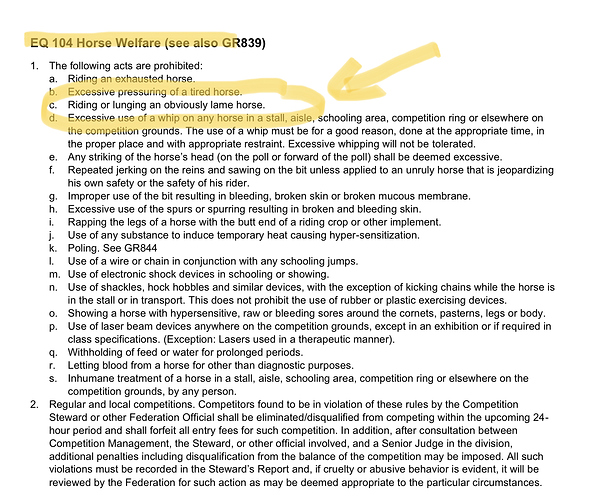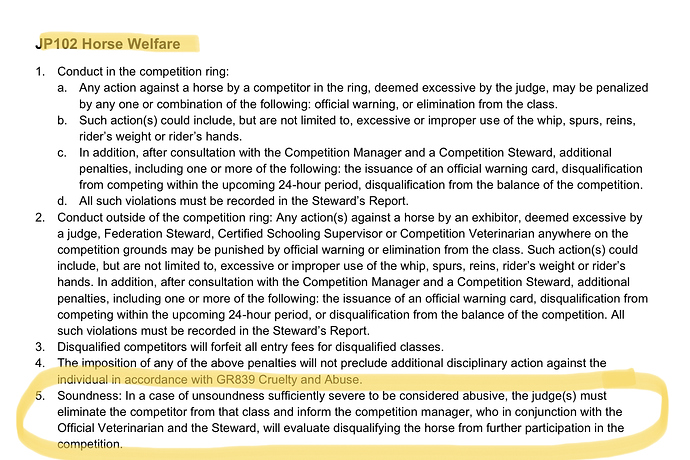Yes. And it’s worth remembering that these horses at this level are likely already getting all the help that is legal to give, like therapies:- PEMF, chiro, massage, laser, shockwave, etc. and legal pharmaceuticals: bute or banamine or equioxx, adequan, legend, etc.
You’re so right. It makes me sad. Whenever they finally get to retire, they’ll be crippled.
Raising the size cutoff for small juniors from 16 hands to 16.1, since there are a lot more entries in the large junior division these days. It’s a current rule change proposal.
So my guess would be, as suggested above, that it was originally intended for horses who have issues that are officially classified as an unsoundness (roaring, sticking their tongue out, having head shaking syndrome, etc) but that are easily managed with care and limiting their use (such as roaring). I can see how a horse having a hitch, but not being “lame” would fall under that category.
It saddens me to see horses who are too kind to say no, just going and going. Those horses are gems and I just don’t think they get nearly the appreciation they deserve. We recently got a horse at our barn who used to do the Big Eq from what I understand, must have had an accident, and they just completely lost his confidence. He’s now a wonderful 2’6 horse for a kiddo, and luckily hasn’t been ridden to death because of his past. I can tell you, that horse KNOWS how lucky is to be where he is now. He all but smiles cantering around with that kid.
I wonder if the juniors should even be split into small/large anymore. I mean, the A/O’s aren’t.
Once upon a time, splitting them made sense because there were so many. That’s not really the case anymore (unless you’re at a very large show).
“That’s just how he goes, but he’s not in pain.”
The ultimate “gray” area - pun half-intended.
At a local show, I can excuse an exhibitor who really doesn’t know better. At the Maclay level, it staggers me.
I’m responding to your comment, not saying “Well, Groom & Taxi believes this!”
I’m sure every single one of us knows a horse about whom we could say this. Heck, right now, I could say this about myself.  I can take people at their word when they say they’ve had the vet involved and they really don’t have any reason to believe the horse is hurting. Think about something like stringhalt- it’s a gait abnormality, but I think generally accepted as not painful to the horse. Here’s why I’m comfortable with a soundness rule applying to a horse who has a non-painful gait abnormality. That horse is predisposed to a compensatory injury in the other limbs, even if the horse isn’t in pain on the affected limb. Those are probably not horses who should be showing in the USEF-sanctioned equitation classes, most of which require a relatively significant level of effort at the horse’s part, which increases the risk of that injury. At a local show, where my theoretical horse with stringhalt is loping around 2’-2’6", the risk of a compensation injury is much lower. Not zero, but lower.
I can take people at their word when they say they’ve had the vet involved and they really don’t have any reason to believe the horse is hurting. Think about something like stringhalt- it’s a gait abnormality, but I think generally accepted as not painful to the horse. Here’s why I’m comfortable with a soundness rule applying to a horse who has a non-painful gait abnormality. That horse is predisposed to a compensatory injury in the other limbs, even if the horse isn’t in pain on the affected limb. Those are probably not horses who should be showing in the USEF-sanctioned equitation classes, most of which require a relatively significant level of effort at the horse’s part, which increases the risk of that injury. At a local show, where my theoretical horse with stringhalt is loping around 2’-2’6", the risk of a compensation injury is much lower. Not zero, but lower.
I don’t think it’s the age as much as the mileage.
Lol, isn’t that a line from Raiders of the Lost Ark? In both cases, it’s the truth!
So Many Lame Horses
I gathered some information from the current edition of the USEF Rulebook regarding soundness in general and in HJEq divisions, selecting those divisions since they seemed the most pertinent.
In addition to EQ102 quoted in the original post:
EQ102 Judging
SOUNDNESS. Unsoundness does not penalize a competitor unless it is sufficiently severe to impair the required performance. In such cases, the imposition of a penalty is at the judge’s discretion.
there is a welfare section under equitation that includes a statement about not showing or lunging an obviously lame horse:
The GR839 referred to in the EQ horse welfare statement reads as follows:
The hunter division has a similar (the same?) set of rules about horse welfare:
The hunter division rules also include the following regarding soundness:
The horse welfare statement for the jumper division is a bit different, but also includes a soundness statement, though it isn’t any more robust that EQ102:
Now adding my opinion of my reading of the existing USEF rules in the above post, as I didn’t want to muddy facts and opinion in one post.
I see a conflict between the soundness statement in the horse welfare rules in the EQ division and what EQ102 says. Also see a conflict between GR840 and the statements about soundness in EQ102 and in the JP horse welfare section. IMHO the line between lame and serviceably sound is a higher bar than unsoundness that inhibits performance (EQ) or is abusive (JP).
Again, IMHO, a good place for USEF to start would be consistency between sections of the rulebook. Then I would start with eq finals requiring horses to jog at some point. It could be included in the schooling rounds they typically have—start and end by having the horse trot a circle of a specified dimension in a specified direction on a long rein.
And it’s the American Society for Prevention of Cruelty to Animals Maclay Finals, just for some more irony. These eq horses are really pounded, and in my area, so are the 2’6" horses at the local shows (where the trainers and the kids gun for oversized year end ribbons like they are headed for the Maclay)
I know back in my mom’s day things like a missing eye or mild roaring were considered an unsoundness.
agree there use to be a rule about soundness in hunters where issues like roaring or a blind eye would be considered an “unsoundness” Now “soundness” does not even have a definition in the rule book
Would really love to hear a judge give some clarity, here. I find it sad that obviously lameness might be dismissed in the Eq. If the judges are going to waffle about “rein lame” or momentary imbalance or irregularity, well isnt that due to Eq and therefore the rider should be sent down.
Now adding my opinion of my reading of the existing USEF rules in the above post, as I didn’t want to muddy facts and opinion in one post.
I see a conflict between the soundness statement in the horse welfare rules in the EQ division and what EQ102 says. Also see a conflict between GR840 and the statements about soundness in EQ102 and in the JP horse welfare section. IMHO the line between lame and serviceably sound is a higher bar than unsoundness that inhibits performance (EQ) or is abusive (JP).
First of all, thank you, @Peggy, for going through these sections of the rulebook- this was one of my projects for the evening and you did it for me.
I agree that the language is contradictory. I favor “serviceably sound” as laid out in GR840, which is specific enough that it can’t be argued that a horse whose unsoundness “does not impair the required performance” is in fact “serviceably sound” only because he didn’t fall down or walk out on three legs today. What do you all think?
As regards testing for soundness, I think asking the horse to jog sound at the schooling class is good, but it’s also too early. Though it adds time to the day, I’d favor jogging the top 25 between rounds of the Medal. If you’re the Brianne Goutal of your generation, the real pressure for your horse to go in unsound is on the second round and the work-off. If your horse comes up lame before the horse show your farm will put you on another horse (we’re talking our theoretical 17-year-old Brianne here, not you or me) and that sucks but you get to horse show. If your horse grabs his heel walking out of the ring and he’s not really right for the second round but you got called back on top… that’s when somebody’s really going to feel pressure to put the horse back in the ring.
And as I said upthread, I’d also support allowing a rider to change horses for the second round, provided the steward and show vet agree the horse is lame, and the horse hasn’t competed with another rider. The competitive advantage of a fresh horse is offset by the fact that that horse hasn’t been in the ring to see the jumps.
agree there use to be a rule about soundness in hunters where issues like roaring or a blind eye would be considered an “unsoundness” Now “soundness” does not even have a definition in the rule book
I showed my previous mare mostly in the (adult) eq because she was a roarer, and under the “serviceably sound” rules for Eq and wouldn’t be disqualified, as she was once at a local rated hunter show. Didn’t effect her performance, didn’t get penalized or effect her performance in Eventing or Dressage either. From that point of view, I understand and appreciate the rule giving horses like that a space to exist in hunter/eq land, because she was so much happier doing eq stuff than eventing.
However, clearly either overall or by this point in the season, some of these horses are not going the way they should. And whether that’s the result of three finals in three weeks, or a whole show season or whatever, it shouldn’t be acceptable.
Think about something like stringhalt- it’s a gait abnormality, but I think generally accepted as not painful to the horse. Here’s why I’m comfortable with a soundness rule applying to a horse who has a non-painful gait abnormality.
One of the top equitation horses we watched yesterday has pretty severe stringhalt, I believe. I’m not naming names because I’m trying to find the article in which it was mentioned, but your comment made me remember that.
JenEM I totally agree. If it were a Dressage class ( let alone a champs) you would be rung out for lameness. I do remember the thought that a roarer or partially blind horse could still do the EQ or jumpers.
I just find it puzzling that something that is supposed to be the pinnacle award for horsemanship fails on the issue of accepting lameness
One of the top equitation horses we watched yesterday has pretty severe stringhalt, I believe. I’m not naming names because I’m trying to find the article in which it was mentioned, but your comment made me remember that.
It’s a tangent, but back about 20 years ago there was a grand prix jumper with really pronounced stringhalt at the walk and the trot. Cantered and jumped great.


 By we digress, carry on
By we digress, carry on




